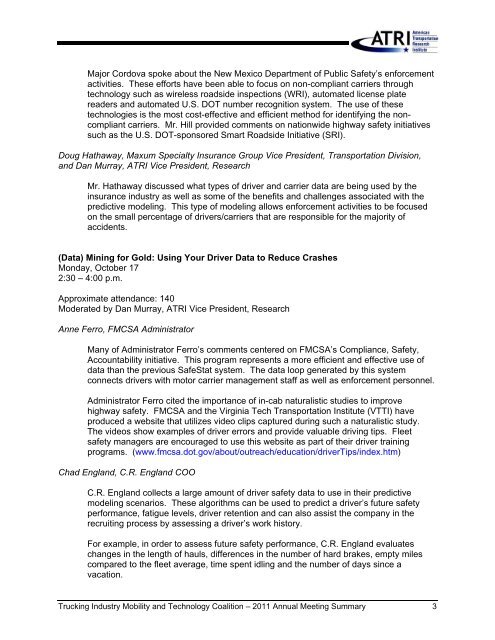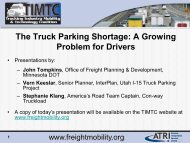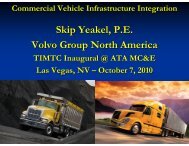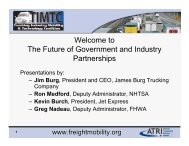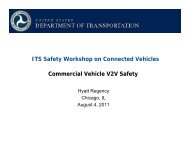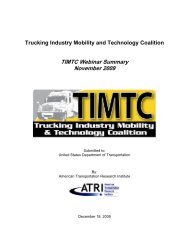Meeting Summary (pdf) - Trucking Industry Mobility and Technology ...
Meeting Summary (pdf) - Trucking Industry Mobility and Technology ...
Meeting Summary (pdf) - Trucking Industry Mobility and Technology ...
You also want an ePaper? Increase the reach of your titles
YUMPU automatically turns print PDFs into web optimized ePapers that Google loves.
Major Cordova spoke about the New Mexico Department of Public Safety’s enforcement<br />
activities. These efforts have been able to focus on non-compliant carriers through<br />
technology such as wireless roadside inspections (WRI), automated license plate<br />
readers <strong>and</strong> automated U.S. DOT number recognition system. The use of these<br />
technologies is the most cost-effective <strong>and</strong> efficient method for identifying the noncompliant<br />
carriers. Mr. Hill provided comments on nationwide highway safety initiatives<br />
such as the U.S. DOT-sponsored Smart Roadside Initiative (SRI).<br />
Doug Hathaway, Maxum Specialty Insurance Group Vice President, Transportation Division,<br />
<strong>and</strong> Dan Murray, ATRI Vice President, Research<br />
Mr. Hathaway discussed what types of driver <strong>and</strong> carrier data are being used by the<br />
insurance industry as well as some of the benefits <strong>and</strong> challenges associated with the<br />
predictive modeling. This type of modeling allows enforcement activities to be focused<br />
on the small percentage of drivers/carriers that are responsible for the majority of<br />
accidents.<br />
(Data) Mining for Gold: Using Your Driver Data to Reduce Crashes<br />
Monday, October 17<br />
2:30 – 4:00 p.m.<br />
Approximate attendance: 140<br />
Moderated by Dan Murray, ATRI Vice President, Research<br />
Anne Ferro, FMCSA Administrator<br />
Many of Administrator Ferro’s comments centered on FMCSA’s Compliance, Safety,<br />
Accountability initiative. This program represents a more efficient <strong>and</strong> effective use of<br />
data than the previous SafeStat system. The data loop generated by this system<br />
connects drivers with motor carrier management staff as well as enforcement personnel.<br />
Administrator Ferro cited the importance of in-cab naturalistic studies to improve<br />
highway safety. FMCSA <strong>and</strong> the Virginia Tech Transportation Institute (VTTI) have<br />
produced a website that utilizes video clips captured during such a naturalistic study.<br />
The videos show examples of driver errors <strong>and</strong> provide valuable driving tips. Fleet<br />
safety managers are encouraged to use this website as part of their driver training<br />
programs. (www.fmcsa.dot.gov/about/outreach/education/driverTips/index.htm)<br />
Chad Engl<strong>and</strong>, C.R. Engl<strong>and</strong> COO<br />
C.R. Engl<strong>and</strong> collects a large amount of driver safety data to use in their predictive<br />
modeling scenarios. These algorithms can be used to predict a driver’s future safety<br />
performance, fatigue levels, driver retention <strong>and</strong> can also assist the company in the<br />
recruiting process by assessing a driver’s work history.<br />
For example, in order to assess future safety performance, C.R. Engl<strong>and</strong> evaluates<br />
changes in the length of hauls, differences in the number of hard brakes, empty miles<br />
compared to the fleet average, time spent idling <strong>and</strong> the number of days since a<br />
vacation.<br />
<strong>Trucking</strong> <strong>Industry</strong> <strong>Mobility</strong> <strong>and</strong> <strong>Technology</strong> Coalition – 2011 Annual <strong>Meeting</strong> <strong>Summary</strong> 3


